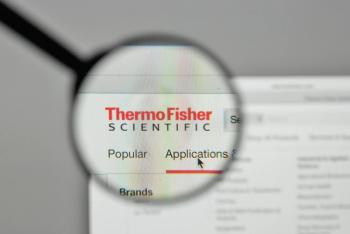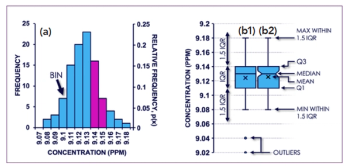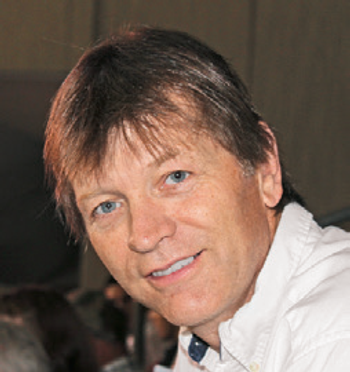
- May 2025
- Volume 2
- Issue 4
- Pages: 14–19
Design of a 3D-Printed Needle-Plate Ion Source for High Field Asymmetric Waveform Ion Mobility Spectrometry
A new paper presents the design of a needle-plate dielectric barrier discharge DBD ion source based on 3D printing for high field asymmetric-waveform ion-mobility spectrometry (FAIMS).
This paper presents the design of a needle-plate dielectric barrier discharge DBD ion source based on 3D printing for high field asymmetric-waveform ion-mobility spectrometry (FAIMS). The ion source uses the 3D printed material resin as the discharge medium, and the mixed gas inlet structure is designed in the same direction to ensure the stability of the plasma jet discharge. The performance of the ion source was verified by integrating it with the FAIMS sensor. The results showed that an alternating current (AC) power supply was needed to make the ion source discharge better. Secondly, the proportion of helium gas introduced into the hollow needle is inversely proportional to the signal strength, and a helium gas flow rate of 0.1 L/min can make FAIMS have better sensitivity. After calculation, the detection line of the FAIMS system for acetone samples under this ion source was determined to be 3.5 ppm.
As a new type of rapid chemical detection technology, high-field asymmetric-waveform ion-mobility spectrometry (FAIMS) distinguishes sample ions based on their different migration rates under high and low electric fields, and has the characteristics of rapid detection and high sensitivity. Since it was published by Buryakov and associates in 1993, researchers have done much research on it. In just a few decades, FAIMS has achieved rapid development, and has been successfully applied to multiple fields such as environmental monitoring, safety maintenance, and exhaled gas detection (1–7).
As the core part of FAIMS, the ion source is responsible for ionizing sample molecules into charged ions, and its performance directly affects the sensitivity, resolution, and accuracy of the entire FAIMS analysis. Ionization methods that can work stably in the atmospheric environment mainly include radioactive ionization, ultraviolet lamp ionization, electric spray ionization, corona discharge ionization, and dielectric barrier discharge ionization, among others (8–11). Photoionization usually uses a 10.6 eV Kr ultraviolet lamp, and the ion types are mainly proton monomers and dimer ions, which are simple and easy to separate by ion filters, but they can only ionize compounds with electron energies less than 10.6 eV. A radioactive source (63Ni) is a convenient, simple, and stable ion source that can operate stably without the need for a power source. However, its disadvantages include radiation safety and licensing issues, which limit its widespread use. Electrospray ionization is only suitable for liquid samples and requires high maintenance. Plasma and corona discharge have high ionization energy, simple electrode structure, and are easy to manufacture, but their ionization products are prone to producing ion fragments.
Dielectric barrier discharge is a gas discharge in which an insulating medium is inserted into the discharge space. The medium can be covered on the electrode or suspended in the discharge space. Early researchers such as Okazaki and co-authors (12) reported the implementation of dielectric barrier glow discharge under conditions of inert gas environment. Since then, more and more researchers have studied it. For example, Garamoon and associates (13) used 50 Hz high-voltage alternating current (AC) to achieve air dielectric barrier glow discharge. Dielectric-barrier discharge (DBD) ion sources have the characteristics of simple structure, convenient operation, and high ionization efficiency. They can be used in conjunction with various analytical instruments for real-time and rapid analysis, with low background noise and high detection sensitivity (14–16). Andriy and co-authors (17) have successfully integrated DBD ion sources with FAIMS and detected various samples, but their ion source preparation is not precise enough and is greatly affected by human factors.
This paper designs a needle-plate dielectric barrier discharge ion source, which is completed by 3D printing, with simple operation, high repeatability, and low time consumption. As an independent component, it was integrated with the migration and detection areas of FAIMS, and a series of FAIMS experiments were carried out. It is proved that the FAIMS under this ion source has good sensitivity and resolution. Using 3D printing to produce ion source and applying it to FAIMS provides a new idea for the design of the analytical instrument.
Materials and Methods
Preparation of Needle-Plate Ion Source
The designed needle-plate dielectric barrier discharge ion source device is shown in Figure 1. Except for the needle and plate electrodes that require external assembly, all other structures are achieved through 3D printing using resin as the printing material.
The device consists of a hollow needle electrode, an external connecting pipe for the needle, a fixed support, a plate electrode, a nitrogen gas inlet device, and a pedestal. The needle electrode is a hollow stainless steel needle with a length of 38 mm and a diameter of 0.5 mm. Inert gas is blown into it through an external connecting pipe, and the addition of inert gas helium (Guangxi Ruida Chemical Technology, 99.999%) can accelerate the ionization of sample molecules (18). A hole with a diameter of 1 mm is designed at the center of the pedestal corresponding to the needle tip, with the purpose of creating a pathway for helium gas and ejecting plasma from the hole. Molten tin-bismuth alloy is poured into an annular cavity with a width of 7 mm and a height of 2 mm through a reserved pouring port, and a wire is buried in the annular cavity for grounding during the pouring process. When the tin-bismuth alloy cools, it forms a plate electrode. The nitrogen carrying sample enters the chamber through the nitrogen inlet, and at the same time, a spaced annular groove with an inner diameter of 3.5 mm and a width of 1 mm is opened on the periphery of the pedestal from the center hole to allow the nitrogen in the chamber to pass through. The structure of helium gas outlet hole and nitrogen annular groove enables the intake of mixed gas to belong to a coaxial structure (19), maintaining the stability of plasma jet discharge without a ecting the structure of the discharge medium. Accurate control of needle-plate spacing is achieved by adjusting the distance between the fixed support and the pedestal. At the same time, four 3-mm diameter holes were opened around the base for assembly with the FAIMS plate.
FAIMS Experimental System
FAIMS consists of ion source, migration region, and detection region. Using copper plating process to design migration area and detection area on parallel printed circuit boards (PCB), with sizes of 15 mm × 12 mm and 12 mm × 10 mm, respectively. For the independent component needle-plate ion source, assembly is performed through the four holes on the pedestal and the positioning holes on the PCB, and a silicone gasket needs to be placed between the ion source pedestal and the PCB upper plate to prevent carrier gas leakage. In order for the plasma jet to be ejected from the needle tip, a 5 mm-diameter outlet is opened at both the upper and lower plates of FAIMS, slightly larger than the nitrogen outlet annular groove. An external sealing cover is required at the outlet of the PCB bottom plate, so that gas can only move between the 2-mm gap between the upper and lower plates.
After assembling FAIMS, AC high voltage is applied to the needle-plate electrode, and with the addition of helium in the hollow needle, plasma is ejected from the needle tip, thereby ionizing the sample molecules carried by nitrogen into charged ions. Under the action of the carrier gas, ions move along parallel plates and are blown to the migration area. The migration zone is loaded with asymmetric square waves and compensation voltages, the frequency of the high-field asymmetric square wave is 1 MHz, the duty cycle is 30%, and the amplitude is adjustable, only ions with specific mobility can reach the detection area. The detection area electrode is connected to a 9 V dry battery, allowing ions that reach the migration area to hit the lower electrode and be detected by subsequent current detectors.
Results
Discharge Comparison of AC and DC
The fixed nitrogen flow rate is 1.5 L/min, helium is 0.2 L/min, and the peak value of AC/(direct current) DC voltage is 4 KV. The FAIMS spectrum of the measured acetone sample is shown in Figure 2.
The abscissa is the value of the compensation voltage. Under the same high field radio frequency (RF) voltage condition, different samples require different compensation voltage, which is the key of FAIMS to distinguish samples. For the same sample, the absolute value of compensation voltage increases with the increase of RF voltage. The ordinate is the signal strength of the measured sample ions by current detectors. At the same sample concentration, the higher the signal strength is, the more ions are ionized by the ion source. As shown in Figure 2, when the needle-plate electrode is powered by an AC power source and no RF voltage is applied, the current overflows. When the RF voltage is increased to 300 V, there is still a significant signal strength and three peaks are generated. When the needle-plate electrode is powered by a DC power supply and the RF voltage is loaded to 200 V, the signal strength drops to 38.3 pA. Continuing to apply RF voltage to 300 V, no signal is detected.
It can be interpreted that in the process of AC dielectric barrier discharge, within half a cycle, as the voltage increases, the electric field reaches the breakdown field strength of the discharge gap, and gap discharge occurs. Charged particles move directionally under the action of the electric field and accumulate on the surface of the insulating medium, forming wall charges. As the accumulated charged particles increase, an electric field Ec opposite to the external electric field Ea is formed in the discharge space, which terminates the discharge process and limits the development of the discharge current. As the applied voltage continues to increase, the applied electric field Ea continues to strengthen, and the spatial electric field E = Ea - Ec reaches the breakdown field strength again. At this point, discharge will occur again in the discharge space. When converted to the other half of the cycle, the electric field formed by the accumulated charges on the surface of the insulating medium is in the same direction as the applied electric field. At the same time, the accumulated charges can also serve as seed electrons for the next discharge, thereby promoting the discharge process (20).
This experiment verifies that using AC power discharge can ionize more ions from the ion source and have better resolution. Therefore, the needle-plate electrode was discharged using AC power for subsequent experiments.
The Influence of Helium Flow Rate
Under the fixed experimental conditions of nitrogen flow rate of 1.5 L/min, needle-plate spacing of 3 mm, voltage peak-to-peak value of 4 KV, and acetone as the sample, the FAIMS spectrum obtained by changing the flow rate of helium is shown in Figure 3. As shown in that figure, when there is no helium introduced into the needle tip, the signal intensity is 0, indicating that only the addition of helium will generate a plasma jet, thereby ionizing the sample. Increasing the helium flow rate to 0.1 L/min results in the highest signal strength. When the RF voltage is 300 V, the main peak signal is higher than 350 pA. As the helium flow rate increases, the signal intensity gradually decreases. When the helium flow rate increases to 0.3 L/min, the signal is basically undetectable, and its curve coincides with the curve when He is 0 L/min.
At the same helium flow rate, the absolute value of the compensation voltage gradually increases with the increase of the RF voltage, and the signal strength decreases, which accords with the law of FAIMS under different RF voltages.
Figure 4 shows the plasma jet generated when different flow rates of helium are introduced into the needle electrode. As shown in the figure, with the increase of helium flow velocity, the plasma jet gradually becomes shorter. This phenomenon explains why the FAIMS signal intensity decreases with increasing helium flow rate. On the one hand, this is because the memory effect of wall charges directly a ects the spatial distribution and discharge properties of the discharge. In addition, the shortened residence time of sample substances in the ionization zone under high flow conditions is also one of the reasons for the change in ionization efficiency.
Limit of Detection
In order to achieve FAIMS spectrum measurement at di erent concentrations, the nitrogen in the experimental system diagram of Figure 5 was divided into two paths, with a total flow rate controlled at 1.5 L/min. One path of nitrogen carried the sample (path 1), while the other path of nitrogen directly entered the electrode plate through the chamber (path 2) (21).
Linearly fit the concentration with the signal intensity detected by FAIMS to obtain the following relationship:
It can be seen from Figure 6 that the relationship between acetone concentration and current is basically linear, with a fitted correlation coefficient R2 = 0.975. The baseline noise of the FAIMS device under this ion source was measured to be 1 pA, and under the condition of a signal-to-noise (S/N) ratio of 3, the detection limit of this device for acetone gas was calculated to be 3.5 ppm.
Conclusion
This paper presents the design of a needle-plate dielectric barrier discharge ion source based on 3D printing for FAIMS. The needle electrode is composed of hollow stainless-steel needles, and the plate electrode is composed of injecting tin bismuth alloy into the annular cavity. This structural design uses 3D printing material resin as the discharge medium, can accurately control the needle-plate spacing through the combination of pedestal and fixed support, and the discharge gas helium and the sample carrying gas nitrogen are designed as coaxial structures to ensure stable discharge of the plasma jet. FAIMS experiments were carried out with the ion source, and AC power supply was used to discharge. It was verified that FAIMS with the ion source can achieve high sensitivity and resolution at a flow rate of 0.1 L/min helium gas.
Acknowledgments
This work was partially supported by College Students Innovation and Entrepreneurship Training Program under Grant Number S202310595321; Guangxi Key Laboratory of Automatic Detecting Technology and Instruments (Guilin University of Electronic Technology) under Grant Number YQ24108.
References
(1) Arasaradnam, R. P.; McFarlane, M.; Daulton, E.; et al. Non-Invasive Exhaled Volatile Organic Biomarker Analysis to Detect Inflammatory Bowel Disease (IBD). Dig. Liv. Dis. 2016, 48 (2), 148–153. DOI:
(2) Arasaradnam, R. P.; McFarlane, M.; Ling, K.; et al. Breathomics--Exhaled Volatile Organic Compound Analysis to Detect Hepatic Encephalopathy: A Pilot Study. J. Breath Res. 2016, 10 (1), 016012. DOI:
(3) Barnett, D. A.; Ouellette, R. J., Elimination of the Helium Requirement in High-field Asymmetric Waveform ion Mobility Spectrometry (FAIMS): Beneficial Effects of Decreasing the Analyzer Gap Width on Peptide Analysis. Rapid Comm. Mass Spect. 2011, 25 (14), 1959–1971. DOI:
(4) Hagemann, L. T.; Repp, S.; Mizaikoff, B. Hybrid Analytical Platform Based on Field-Asymmetric Ion Mobility Spectrometry, Infrared Sensing, and Luminescence-Based Oxygen Sensing for Exhaled Breath Analysis. Sensors 2019, 19 (12), 2653. DOI:
(5) Kolakowski, B. M.; Mester, Z. Review of Applications of High-Field Asymmetric Waveform Ion Mobility Spectrometry (FAIMS) and Differential Mobility Spectrometry (DMS). Analyst 2007, 132 (9), 842–864. DOI:
(6) Li, J. H.; Gao, W. Q.; Wu, H. M.; et al. On the Resolution, Sensitivity and Ion Transmission Efficiency of a Planar FAIMS. Int. J. Mass Spectrom. 2022, 471, 116727. DOI:
(7) Purves, R. W.; Prasad, S.; Belford, M.; et al. Optimization of a New Aerodynamic Cylindrical FAIMS Device for Small Molecule Analysis. J. Am. Soc. Mass Spectrom. 2017, 28 (3), 525–538. DOI:
(8) Fenn, J.; Mann, M.; Meng, C.; Wong, S.; et al. Electrospray Ionization for Mass Spectrometry of Large Biomolecules. Science 1989, 246 (4926), 64–71. DOI:
(9) Liu, K.; Zhang, X.; Zhou, X.; et al. Experimental Investigation of an Atmospheric Pressure Plasma Jet as an Ion Source for On-Site Mass-Spectrometry Analysis of Nonvolatile Solid Samples: The Integration Effect of Thermal Desorption and Ionization. J. Phys. D: Appl. Phys. 2022, 55 (48), 485202. DOI:
(10) Ran, C.; Zhou, X.; Wang, Z.; Liu, K.; Ostrikov, K. Ultralong-Lasting Plasma-Activated Water: Production and Control Mechanisms. PSST 2024, 33 (1), 015009. DOI:
(11) Zhou, X.; Xiang, H. F.; Yang, M.; et al. Temporal Evolution Characteristics of the Excited Species in a Pulsed Needle-Water Discharge: Effect of Voltage and Frequency. J. Phys. D: Appl. Phys. 2023, 56, 455202. DOI:
(12) Kanazawa, S.; Kogoma, M.; Moriwaki, T.; Okazaki, S. Stable Glow Plasma at Atmospheric Pressure. J. Phys. D: Appl. Phys. 1988, 21 (5), 838. DOI:
(13) Garamoon, A. A.; El-Zeer, D. M. J. P. S. S. Technology, Atmospheric Pressure Glow Discharge Plasma in Air at Frequency 50Hz. PSST 2009, 18 (4), 045006. DOI:
(14) Ding, X.; Zhan, X.; Yuan, X.; Zhao, Z.; Duan, Y. Microfabricated Glow Discharge Plasma (MFGDP) for Ambient Desorption/Ionization Mass Spectrometry. Anal. Chem. 2013, 85 (19), 9013–9020. DOI:
(15) Iza, F.; Kim, G. J.; Lee, S. M.; et al. Microplasmas: Sources, Particle Kinetics, and Biomedical Applications. Plasma Process. Polym. 2008, 5 (4) 322–344. DOI:
(16) Hu, J.; Li, W.; Zheng, C.; Hou, X. Dielectric Barrier Discharge in Analytical Spectrometry. Appl. Spectrosc. Rev. 2011, 46 (5), 368–387. DOI:
(17) Kuklya, A.; Engelhard, C.; Uteschil, F.; et al. Low-Temperature Plasma Ionization Differential Ion Mobility Spectrometry. Anal. Chem. 2015, 87 (17), 8932–8940. DOI:
(18) Li, H.; Du, X.; Zeng, H.; et al. Helium-Assisted Enhanced Discharge in a Hollow Needle for High-Field Asymmetric Ion Mobility Spectrometry (FAIMS). Anal. Bioanal. Chem. 2021, 413 (11), 2855–2866. DOI:
(19) Wei, Z.; Du, X.; Zeng, H.; et al. Simultaneously Improving the Resolving Power and Sensitivity for Planar High Field Asymmetric Waveform Ion Mobility Spectrometry Using a Mixed Gas Inlet Mode at Two Ends. Rapid Commun. Mass Spectrom. 2021, 35 (23), e9198. DOI:
(20) Shao, T.; Yan, P. Atmospheric Pressure Gas Discharge and its Plasma Application. J. Sci. Phy. 2015, 113, 97.
(21) Du, X.; Mou, J.; Zeng, H.; et al. Printed Circuit Board (PCB) Brazing and Ion Source Integration of a High-Field Asymmetric Ion Mobility Spectrometry (FAIMS) Chip. Anal. Lett. 2020, 54 (8), 1377–1388. DOI:
About the Authors
Dongmei Li, Yuqiao Zhang, Peng Shang, Kaikun Zhong and Xiaoxia Du are with the School of Life and Environmental Sciences, at Guilin University of Electronic Technology, in Guilin, Guangxi, China. Xiaoxia Du is also with the Guangxi Key Laboratory of Automatic Detecting Technology and Instruments, at Guilin University of Electronic Technology, in Guilin, Guangxi, China. Direct correspondence to:
Articles in this issue
8 months ago
In Bruges: The HPLC 2025 ConferenceNewsletter
Join the global community of analytical scientists who trust LCGC for insights on the latest techniques, trends, and expert solutions in chromatography.




